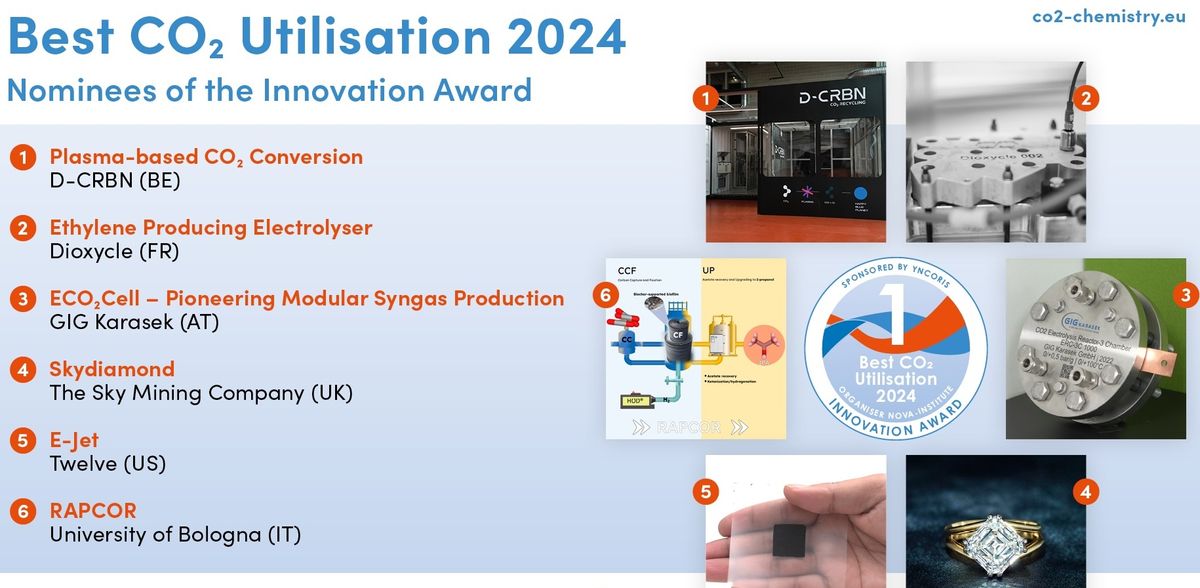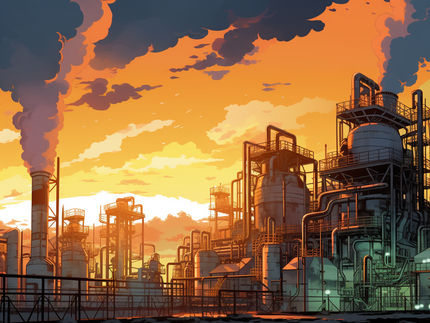Advancements in Carbon Capture and Utilisation (CCU) Technology Pave the Way for Novel Applications From Ethylene, to Polymers, Syngas and Even Diamonds
Tough competition of outstanding innovations unveiled at the CO2-based Fuels and Chemicals Conference 2024
This year's nominees for the innovation award “Best CO2-Utilisation 2024” prove that CO2 innovations can be used to produce syngas, polymers, organic fatty acids, ethylene, renewable isopropyl alcohol (IPA), but also aviation fuels and diamonds.
The award is one of the highlights of the CO2-based Fuels and Chemicals Conference and puts a spotlight on innovative products and technologies in the field of Carbon Capture and Utilisation (CCU). An expert jury and the conference advisory board and sponsors selected six promising nominees among the interesting submissions received. Those will have the chance to present their CO2 innovation to a broad international audience at Maternushaus, Cologne (Germany) and online on the 17th of April 2024.
Honouring six CO₂ pioneers
D-CRBN – Plasma-based CO2 Conversion – (BE): D-CRBN is a three-year-old CCU spin-off from the University of Antwerp. The company has established a proprietary modular and scalable plasma technology capable of splitting the CO2 molecule into CO, all in a fully electrified, gaseous phase, without solvents or catalysts. The CO is then turned into added-value chemicals, such as e-fuels, organic acids, polymers, etc. that are used as feedstocks for the chemical, petrochemical, maritime, and metallurgical industries among others.
Dioxycle – Ethylene Producing Electrolyser – (FR): Dioxycle is pioneering a breakthrough carbon electrolysis technology that converts industrial emissions into sustainable ethylene using just renewable electricity and water. As a result, Dioxycle can produce carbon-neutral ethylene cost competitively with the fossil pathway, providing an economically attractive pathway to defossilise many industrial and commercial sectors. Ethylene is the world’s most used organic chemical, finding application in key everyday products such as textile fibres, plastics, and construction materials.
GIG Karasek– ECO2Cell – Pioneering Modular Syngas Production – (AT): ECO2Cell is a cutting-edge, modular plant for producing syngas through low-temperature electrochemical conversion of CO2. This innovative technology platform efficiently converts CO2 into valuable chemicals and fuels, promoting a circular economy. Its modular design ensures scalability and adaptability to various industrial applications, offering a sustainable and cost-effective solution for CO2 emission challenges.
The Sky Mining Company – Skydiamond – (UK): Skydiamond, the world's first carbon-negative diamond, is mined from the sky. The Sky Mining Company created an alternative to the destructive act of land mining. Skydiamonds are planet-positive, certified, and chemically identical to the timeless diamonds. This carbon-capture innovation is a patented and bespoke biological process operating out of the English countryside using only four ingredients; rainwater, solar and wind power and of course, atmospheric carbon, making these the most sustainable diamonds in the world.
Twelve – E-Jet®– (US): E-Jet® fuel, Twelve’s sustainable aviation fuel (SAF) made from CO2, is produced with only three inputs – water, renewable electricity, and CO2. E-Jet® fuel was tested and certified by the U.S. Air Force in 2021, drop-in ready for use in existing aircraft, made to ASTM D7566 specifications, the same performance standard as fossil-based jet fuel. All with up to 90 % lower lifecycle emissions and fewer sulfur dioxide (SO2), nitrogen oxides (NOx), and other particulate emissions.
University of Bologna – RAPCOR – (IT): The RAPCOR concept aims to convert flue gas carbon into renewable isopropyl alcohol (IPA), serving as a versatile fuel, energy carrier, hydrogen carrier, or commodity chemical. RAPCOR approach uses microbial mixed culture (MMC, consisting of anaerobic homoacetogens) supported on a peculiar char-based sparger reactor to reduce bicarbonate with renewable hydrogen, thus obtaining high concentration (>60 g/L) acetate, which is ketonised and hydrogenated to IPA. This process works at mild pressure and temperature and allows to overcome most of the limitations of existing Power-To-Fuel pathways.
Most read news
Topics
Organizations
Other news from the department business & finance
These products might interest you

Eclipse by Wyatt Technology
FFF-MALS system for separation and characterization of macromolecules and nanoparticles
The latest and most innovative FFF system designed for highest usability, robustness and data quality

Spinsolve Benchtop NMR by Magritek
Spinsolve Benchtop NMR
Spinsolve is a revolutionary multinuclear NMR spectrometer that provides the best performance

HYPERION II by Bruker
FT-IR and IR laser imaging (QCL) microscope for research and development
Analyze macroscopic samples with microscopic resolution (5 µm) in seconds

Get the chemical industry in your inbox
By submitting this form you agree that LUMITOS AG will send you the newsletter(s) selected above by email. Your data will not be passed on to third parties. Your data will be stored and processed in accordance with our data protection regulations. LUMITOS may contact you by email for the purpose of advertising or market and opinion surveys. You can revoke your consent at any time without giving reasons to LUMITOS AG, Ernst-Augustin-Str. 2, 12489 Berlin, Germany or by e-mail at revoke@lumitos.com with effect for the future. In addition, each email contains a link to unsubscribe from the corresponding newsletter.



























































